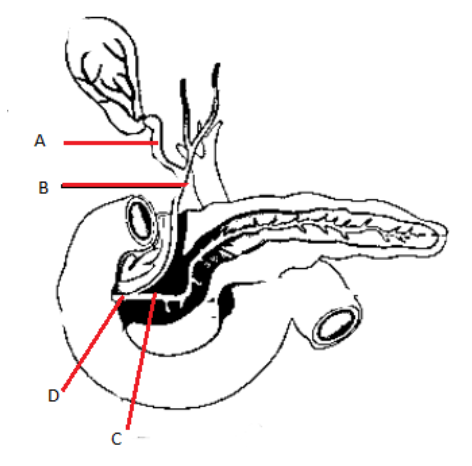
The given diagram shows a duct system of liver, gall-bladder and pancreas. Write the names of ducts from A to D.
a. A-Cystic duct, B – Common bile duct, C – Pancreatic duct, D – Hepato-pancreatic duct
b. A – Common bile duct, B – Cystic duct, C – Pancreatic duct, D – Hepato-pancreatic duct
c. A – Cystic Duct, B – Bile duct, C – Hepato-pancreatic duct, D – Pancreatic duct
d. A – Cystic Duct, B – Pancreatic duct, C – Common bile duct, D- Hepato-pancreatic duct


Answer
549.6k+ views
Hint: The gastrointestinal tract consists of a series of hollow organs and tubes that begin from the mouth, through the stomach, small intestines, large intestines, and end at the anus. Different organs secrete a variety of enzymes that aid in digestion as the food particles are gradually digested as they pass through the different compartments of the gastrointestinal tract.
Complete answer:
Three accessory digestive organs are responsible for digestion in the small intestine: the liver, the pancreas, and the gallbladder. The liver's digestive function is to generate bile and export it to the duodenum. In the liver, bile helps to digest and absorb fats, vitamins and cholesterol is made. The gallbladder stores concentrate and release bile. The pancreas produces pancreatic juice and sends it to the duodenum, containing digestive enzymes and bicarbonate ions.
In the gall-bladder, the bile flows into the cystic duct. The cystic joins the common hepatic duct, creating the common bile duct from which the bile flows into the small intestine. Pancreatic juice and bile juice are secreted together into the duodenum via the hepatic duct. Pancreatic juice is also present in the secretion from the hepato-pancreatic duct.
Hence, the correct answer is option (A), A-Cystic duct, B – Common bile duct, C – Pancreatic duct, D – Hepato-pancreatic duct.
Note: The pancreas releases digestive enzymes such as proteases, amylases and lipases. These enzymes assist in the absorption of sugar, proteins and fat. The pancreas secretes hormones such as insulin and glucagon into the blood and the islets of Langerhans are embedded in it, and these hormones are released by beta cells and alpha cells respectively.
Complete answer:
Three accessory digestive organs are responsible for digestion in the small intestine: the liver, the pancreas, and the gallbladder. The liver's digestive function is to generate bile and export it to the duodenum. In the liver, bile helps to digest and absorb fats, vitamins and cholesterol is made. The gallbladder stores concentrate and release bile. The pancreas produces pancreatic juice and sends it to the duodenum, containing digestive enzymes and bicarbonate ions.
In the gall-bladder, the bile flows into the cystic duct. The cystic joins the common hepatic duct, creating the common bile duct from which the bile flows into the small intestine. Pancreatic juice and bile juice are secreted together into the duodenum via the hepatic duct. Pancreatic juice is also present in the secretion from the hepato-pancreatic duct.
Hence, the correct answer is option (A), A-Cystic duct, B – Common bile duct, C – Pancreatic duct, D – Hepato-pancreatic duct.
Note: The pancreas releases digestive enzymes such as proteases, amylases and lipases. These enzymes assist in the absorption of sugar, proteins and fat. The pancreas secretes hormones such as insulin and glucagon into the blood and the islets of Langerhans are embedded in it, and these hormones are released by beta cells and alpha cells respectively.
Recently Updated Pages
Why are manures considered better than fertilizers class 11 biology CBSE

Find the coordinates of the midpoint of the line segment class 11 maths CBSE

Distinguish between static friction limiting friction class 11 physics CBSE

The Chairman of the constituent Assembly was A Jawaharlal class 11 social science CBSE

The first National Commission on Labour NCL submitted class 11 social science CBSE

Number of all subshell of n + l 7 is A 4 B 5 C 6 D class 11 chemistry CBSE

Trending doubts
1 Quintal is equal to a 110 kg b 10 kg c 100kg d 1000 class 11 physics CBSE

Why is steel more elastic than rubber class 11 physics CBSE

What is boron A Nonmetal B Metal C Metalloid D All class 11 chemistry CBSE

Bond order ofO2 O2+ O2 and O22 is in order A O2 langle class 11 chemistry CBSE

Discuss the various forms of bacteria class 11 biology CBSE

What is the difference between biodegradable and nonbiodegradable class 11 biology CBSE




